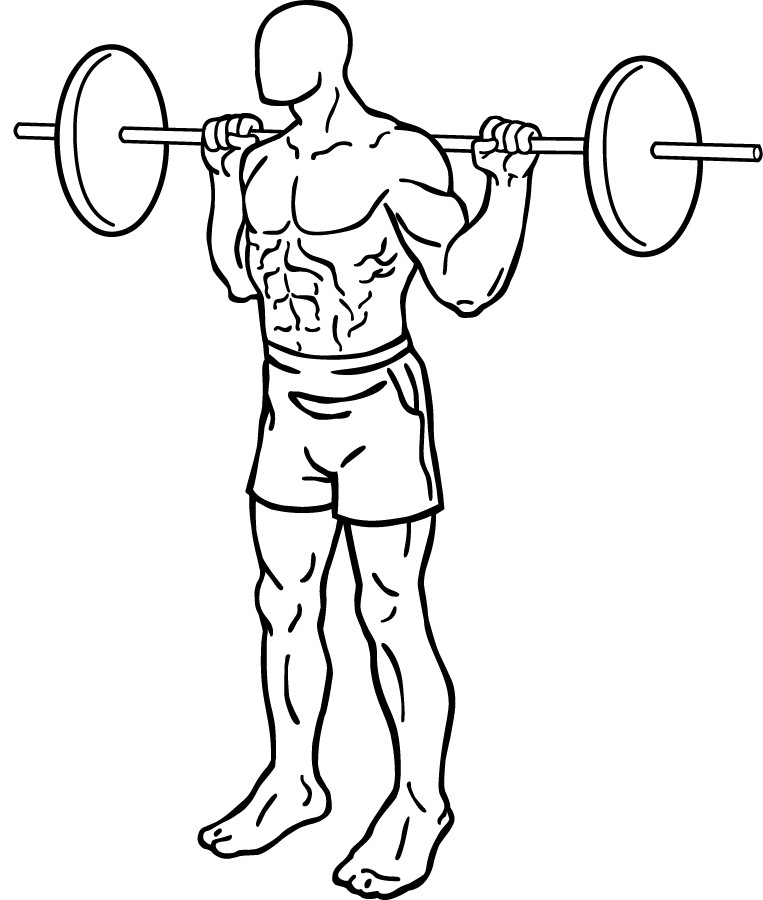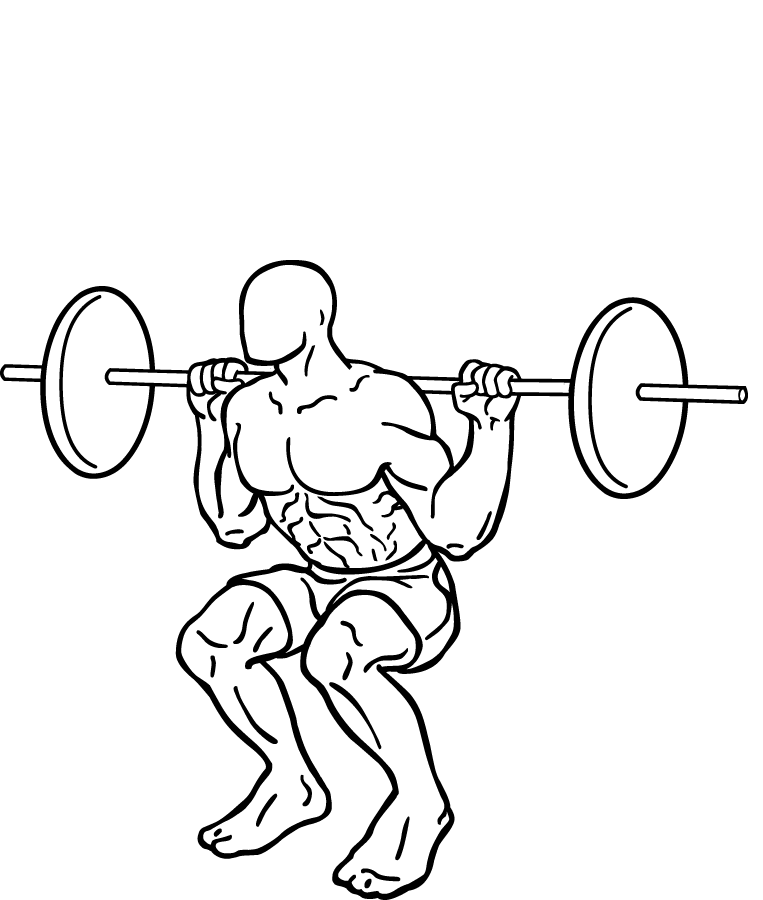Last Updated on September 25, 2014
When it comes to building raw strength, power, and muscle mass, especially in your lower body, no exercise reigns supreme like the barbell squats. Whether you’re a beginner at the gym or an experienced lifter, this foundational exercise is an absolute must if your goal is to strengthen and develop your quadriceps, hamstrings, glutes, and even core.
Squats are a compound movement, meaning they target multiple muscle groups simultaneously, making them highly efficient for both muscle growth and functional strength. But as simple as they may appear, squats are often done incorrectly, which not only limits their effectiveness but also increases your risk of injury.
In this in-depth guide, we’ll break down everything you need to know about barbell squats, from proper form to common mistakes, and explain why they’re essential in any workout routine.
Why Are Barbell Squats So Important?
Squats are considered one of the “Big Three” lifts in the world of strength training, alongside the bench press and deadlift. The reason they’re held in such high regard is because of their ability to build full-body strength. While they primarily target your legs, they also engage your core, lower back, and even your upper body to some extent, especially when performing barbell squats.
Here’s why you should prioritize barbell squats in your workout regimen:
Builds Lower Body Strength: Squats are hands down one of the best exercises to target your quadriceps, hamstrings, glutes, and calves. By performing squats with a barbell, you increase the load and intensity, which leads to greater muscle activation and growth.
Improves Core Strength: Maintaining proper posture during a squat requires significant core engagement. The deeper you squat, the more your core muscles have to work to stabilize your torso and protect your spine.
Enhances Athletic Performance: Squatting builds explosive power, which is essential for athletes in sports that require jumping, sprinting, or quick changes in direction. Strong legs also translate to better overall athletic performance.
- Burns Calories: Since squats involve large muscle groups, they burn more calories than isolation exercises. The more muscle mass you engage, the higher your metabolic rate becomes, helping you burn fat more effectively.
Boosts Hormonal Release: Squats stimulate the release of hormones like testosterone and growth hormone, both of which are critical for muscle growth and recovery. Performing heavy squats regularly can increase your body’s natural production of these muscle-building hormones.
Step-by-Step Guide to Performing the Perfect Barbell Squat
Performing squats with a barbell may look straightforward, but the devil is in the details. Here’s a breakdown of each step to ensure you’re getting the most out of this powerful exercise while minimizing the risk of injury.
Step 1: Setting Up the Barbell
Before you even begin squatting, you’ll need to properly set up the barbell on a squat rack. This involves adjusting the height of the bar so that it sits comfortably at shoulder level.
Bar Height: Adjust the barbell so that it’s about the same height as your upper chest or just below your shoulders. This will allow you to lift the barbell easily when you’re ready to squat.
Grip the Barbell: Grasp the barbell with both hands, positioning them just outside your shoulders. Keep your hands wrapped tightly around the bar to maintain control and stability throughout the movement.
Step 2: Positioning the Barbell on Your Back
Now that your bar is set, it’s time to position it correctly on your upper back. There are two common positions for the barbell:
High-Bar Position: The barbell rests on top of your trapezius muscles, just below the base of your neck. This position keeps your torso more upright and places more emphasis on your quadriceps.
Low-Bar Position: The barbell sits lower, across your rear deltoids, which forces you to lean forward slightly. This position tends to shift more of the load onto your hips and glutes, making it ideal for those who want to focus on overall strength and powerlifting.
For most beginners, the high-bar position is more comfortable and easier to master.
Step 3: Foot and Body Positioning
Foot placement is crucial in determining which muscles are activated during the squat. Here’s how to position your feet:
Feet Width: Place your feet slightly wider than shoulder-width apart. This provides a stable base of support and allows you to squat deeper.
Toe Angle: Turn your toes out slightly, around 15 to 30 degrees. This helps keep your knees in alignment with your feet and allows for a more natural range of motion.
Brace Your Core: Before you begin the descent, brace your core by taking a deep breath and tightening your abdominal muscles. This will protect your spine and prevent your lower back from rounding.
Step 4: Descending into the Squat
Now that you’re in position, it’s time to begin the actual movement. Here’s how to squat properly:
Initiate the Movement: Begin by pushing your hips back, as if you’re sitting into a chair. This will engage your glutes and hamstrings, and ensure that your knees don’t extend too far past your toes.
Lower Slowly: As you push your hips back, bend your knees to lower your body. Descend slowly and in control, keeping your weight evenly distributed through your feet. Avoid shifting forward onto your toes, which can lead to instability and poor form.
Go as Deep as Possible: Lower yourself until your hips drop just below your knees—this is known as breaking parallel. If you have good flexibility and mobility, you may be able to squat even deeper, but make sure you’re maintaining proper form throughout.
Step 5: Pausing at the Bottom
At the bottom of the squat, take a brief pause. This isn’t just a resting point; it allows you to stabilize and make sure your form is intact. While paused, keep your core engaged and your chest up. Your knees should be in line with your toes, and your heels should remain planted firmly on the ground.
Step 6: Rising to the Top
After the brief pause, begin to push back up into the starting position:
Drive Through Your Heels: Push through your heels to engage your quadriceps and glutes. This ensures that your lower body muscles are doing the majority of the work, rather than your lower back.
Keep Your Core Engaged: Maintain tightness in your core as you ascend. This will help protect your spine and prevent you from leaning forward.
Finish Upright: Once you reach the top, make sure your hips are fully extended, and you’re standing upright with the barbell still balanced on your shoulders.
Repeat this process for the desired number of repetitions, maintaining strict form throughout.
Common Mistakes to Avoid When Performing Barbell Squats
As effective as squats are, they can lead to injury if performed incorrectly. Here are some common mistakes and how to avoid them:
Knees Caving Inward (Valgus Collapse): One of the most common mistakes during squats is allowing your knees to cave inward, which places undue stress on your knee joints. To avoid this, focus on pushing your knees outward and keeping them in line with your toes throughout the movement.
Rounding the Lower Back: This usually happens when lifters try to squat too deep without maintaining core tightness. Keep your core engaged and avoid excessive forward lean by ensuring the barbell stays over your midfoot.
Lifting the Heels Off the Ground: If your heels rise off the ground during the squat, it indicates poor ankle mobility or improper weight distribution. Work on your ankle flexibility and ensure that you’re pushing through your heels rather than your toes.
Leaning Too Far Forward: This often occurs when the barbell is placed too far forward on the shoulders or when you don’t engage your core. Focus on keeping your chest up and driving through your heels to maintain proper posture.
Going Too Heavy Too Soon: While it can be tempting to load up the barbell with heavy weights, form should always take precedence. Start with a manageable weight and gradually increase as you become more comfortable with the movement.
Benefits of Barbell Squats: More Than Just Leg Gains
While barbell squats are well-known for building strong legs, the benefits of this exercise extend far beyond the quadriceps. Here are some additional advantages of incorporating squats into your routine:
1. Improves Flexibility
Squatting through a full range of motion helps improve flexibility in your hips, knees, and ankles. This is especially beneficial for people who have sedentary lifestyles or spend long hours sitting.
2. Boosts Core Strength and Stability
Maintaining an upright posture while squatting places a significant demand on your core muscles. This leads to improved core strength and stability, which translates into better performance in other lifts and everyday activities.
3. Strengthens the Posterior Chain
The posterior chain refers to the muscles on the back side of your body, including your hamstrings, glutes, and lower back. Squats heavily recruit these muscles, helping to balance your physique and prevent muscle imbalances that can lead to injury.
4. Promotes Hormonal Growth
As a compound exercise, squats stimulate the release of muscle-building hormones like testosterone and growth hormone. These hormones not only aid in muscle recovery but also promote overall muscle growth.
5. Enhances Balance and Coordination
Squatting requires precise coordination between your lower and upper body, as well as balance and stability. Over time, this improves your overall balance and can even enhance athletic performance in sports or activities that require agility and coordination.
Variations of the Barbell Squat
Once you’ve mastered the basic barbell squat, you can try different variations to challenge your muscles in new ways:
Front Squat: In this variation, the barbell is positioned across the front of your shoulders, placing more emphasis on your quadriceps and core.
Box Squat: This involves squatting down onto a box or bench, which helps ensure that you’re squatting to a consistent depth and improves your ability to sit back into the squat.
Bulgarian Split Squat: This single-leg squat variation targets your glutes and quads while improving balance and stability.
Barbell squats are one of the most effective exercises for building lower body strength, enhancing athletic performance, and promoting overall muscle growth. While they may seem simple, perfecting your squat form takes time, patience, and attention to detail.
By following the steps outlined in this guide and avoiding common mistakes, you’ll be well on your way to mastering the barbell squat and reaping its incredible benefits. Incorporate this powerhouse exercise into your workout routine, and watch your strength, muscle mass, and overall fitness levels soar.







